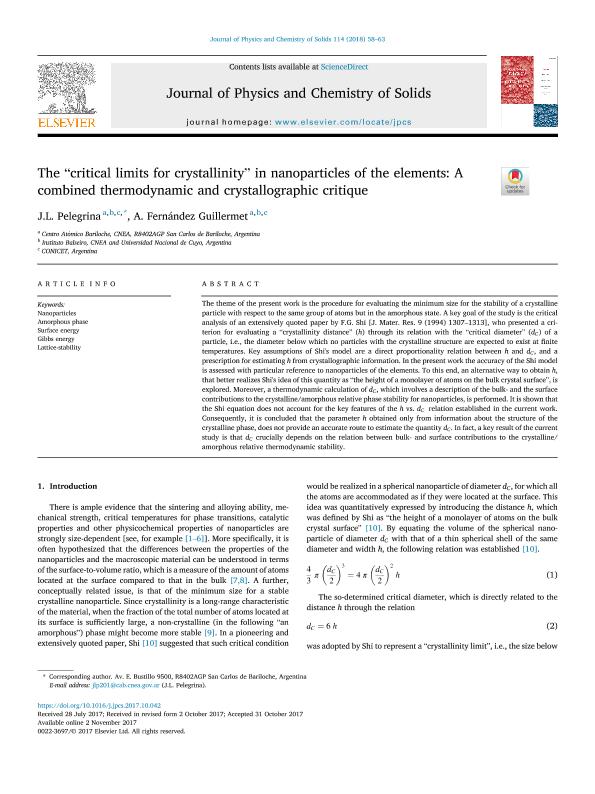Mostrar el registro sencillo del ítem
dc.contributor.author
Pelegrina, Jorge Luis

dc.contributor.author
Fernandez Guillermet, Armando Jorge

dc.date.available
2020-02-10T21:43:59Z
dc.date.issued
2018-03
dc.identifier.citation
Pelegrina, Jorge Luis; Fernandez Guillermet, Armando Jorge; The “critical limits for crystallinity” in nanoparticles of the elements: A combined thermodynamic and crystallographic critique; Pergamon-Elsevier Science Ltd; Journal of Physics and Chemistry of Solids; 114; 3-2018; 58-63
dc.identifier.issn
0022-3697
dc.identifier.uri
http://hdl.handle.net/11336/97135
dc.description.abstract
The theme of the present work is the procedure for evaluating the minimum size for the stability of a crystalline particle with respect to the same group of atoms but in the amorphous state. A key goal of the study is the critical analysis of an extensively quoted paper by F.G. Shi [J. Mater. Res. 9 (1994) 1307–1313], who presented a criterion for evaluating a “crystallinity distance” (h) through its relation with the “critical diameter” (dC) of a particle, i.e., the diameter below which no particles with the crystalline structure are expected to exist at finite temperatures. Key assumptions of Shi's model are a direct proportionality relation between h and dC, and a prescription for estimating h from crystallographic information. In the present work the accuracy of the Shi model is assessed with particular reference to nanoparticles of the elements. To this end, an alternative way to obtain h, that better realizes Shi's idea of this quantity as “the height of a monolayer of atoms on the bulk crystal surface”, is explored. Moreover, a thermodynamic calculation of dC, which involves a description of the bulk- and the surface contributions to the crystalline/amorphous relative phase stability for nanoparticles, is performed. It is shown that the Shi equation does not account for the key features of the h vs. dC relation established in the current work. Consequently, it is concluded that the parameter h obtained only from information about the structure of the crystalline phase, does not provide an accurate route to estimate the quantity dC. In fact, a key result of the current study is that dC crucially depends on the relation between bulk- and surface contributions to the crystalline/amorphous relative thermodynamic stability.
dc.format
application/pdf
dc.language.iso
eng
dc.publisher
Pergamon-Elsevier Science Ltd

dc.rights
info:eu-repo/semantics/openAccess
dc.rights.uri
https://creativecommons.org/licenses/by-nc-nd/2.5/ar/
dc.subject
AMORPHOUS PHASE
dc.subject
GIBBS ENERGY
dc.subject
LATTICE-STABILITY
dc.subject
NANOPARTICLES
dc.subject
SURFACE ENERGY
dc.subject.classification
Física de los Materiales Condensados

dc.subject.classification
Ciencias Físicas

dc.subject.classification
CIENCIAS NATURALES Y EXACTAS

dc.title
The “critical limits for crystallinity” in nanoparticles of the elements: A combined thermodynamic and crystallographic critique
dc.type
info:eu-repo/semantics/article
dc.type
info:ar-repo/semantics/artículo
dc.type
info:eu-repo/semantics/publishedVersion
dc.date.updated
2019-10-15T17:29:52Z
dc.journal.volume
114
dc.journal.pagination
58-63
dc.journal.pais
Estados Unidos

dc.description.fil
Fil: Pelegrina, Jorge Luis. Comisión Nacional de Energía Atómica. Gerencia del Area de Investigación y Aplicaciones No Nucleares. Gerencia de Física (Centro Atómico Bariloche); Argentina. Consejo Nacional de Investigaciones Científicas y Técnicas; Argentina
dc.description.fil
Fil: Fernandez Guillermet, Armando Jorge. Comisión Nacional de Energía Atómica. Gerencia del Area de Investigación y Aplicaciones No Nucleares. Gerencia de Física (Centro Atómico Bariloche); Argentina. Consejo Nacional de Investigaciones Científicas y Técnicas; Argentina
dc.journal.title
Journal of Physics and Chemistry of Solids

dc.relation.alternativeid
info:eu-repo/semantics/altIdentifier/doi/http://dx.doi.org/10.1016/j.jpcs.2017.10.042
dc.relation.alternativeid
info:eu-repo/semantics/altIdentifier/url/https://www.sciencedirect.com/science/article/pii/S0022369717313781
Archivos asociados
